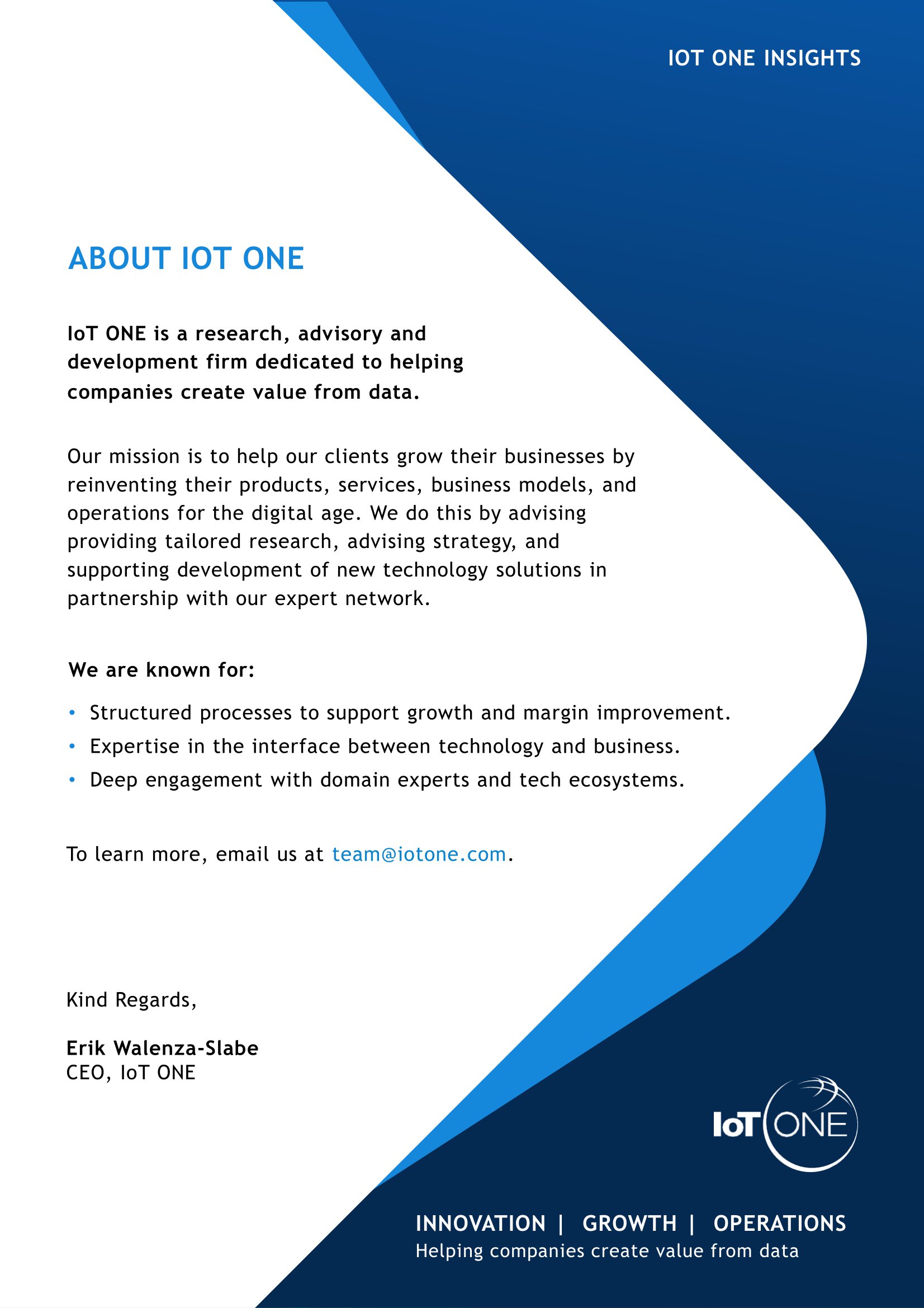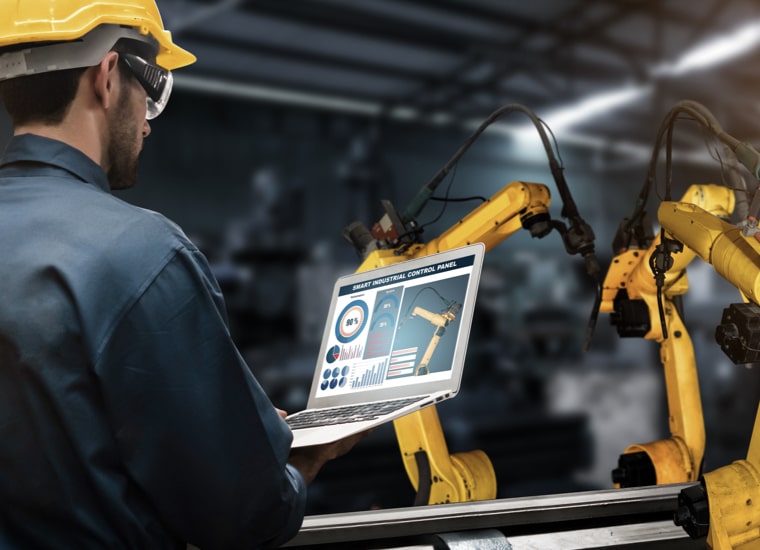SPOTLIGHT PODCAST EP. 160: How to scale IoT globally and affordably
About Ivo Rook - President and COO of 1NCE
Ivo started his career at telecommunications in the 1990s with KPN. He has since held positions as Executive Vice President of Network Outsourcing at T-Systems, CEO of IoT for Vodafone, and Senior Vice President for IoT at Sprint. He is also an independent advisor and investor with I Squared Capital and is a Board Member of Global Telecom and a Board Advisor of Digitize Things.
“When I got into IoT, I was really inspired by what our customers were doing. They were changing the world by enabling things that previously weren't possible. The more I understood that, the more I wanted to work for a company that truly enables customers to change the world for the better using connectivity technology at a global scale.”
About 1NCE - www.1nce.com
1NCE is the only provider of connectivity and software for IoT at a global flat rate – offering fast, secure, and reliable cellular connectivity and software services in more than 110 countries worldwide. The 1NCE IoT Flat Rate is designed to last over the entire lifetime of an IoT device with a one-off payment of $10 for 10 years, making IoT applications affordable and scalable for smart utilities, asset tracking, vehicle telematics and other uses. The company – founded in 2017 by CEO Alexander Sator together with Deutsche Telekom AG – is headquartered in Cologne, Germany and has over 200 staff.
1NCE GROWTH STORY
Erik: You have this incredible background in IoT connectivity – CEO IoT for Vodafone, SVP IoT for Sprint, EVP IoT for T-Systems. You're certainly the person to talk to about the next generation of IoT connectivity. What was it that first drew you to the telco industry?
Ivo: 25 years in telco makes me sound old but let's call it experienced. I’ve really seen it all, from wireline to mobile to IoT. I think that IoT is the pinnacle of telecommunications because it combines networking from the wireline, connecting super mission critical B2B datacenters with mobile. Mobile has the potential to provide connectivity anywhere in the world.
When I got into IoT, I was really inspired by what our customers were doing. They were changing the world by enabling things that previously weren't possible. The more I understood that, the more I wanted to work for a company that truly enables customers to change the world for the better using connectivity technology at a global scale.
My realization was that you've got big operators on one hand who are incredibly successful. And then you've got small companies with fascinating IT capabilities and truly brilliant global reach, but they don't have the cost base of the operators. I was thinking about combining all those assets and creating a new company. But I didn't get that far since I was working at an investor at I Squared Capital and we decided to invest in 1NCE. A few months later I joined the company as president. Why? Because 1NCE itself has the critical ingredients to address IoT very successfully.
Erik: Why now? Were there technological shifts that made this business possible now, whereas 10 years it wasn't possible? Or, was it an inspired founding team that saw demand reaching a critical scale?
Ivo: There were multiple things that came together. 1NCE has a very interesting vision. The team works really hard to change the IoT supply chain with new technology and commercial models. I thought that was very refreshing because it's a realization the supply chain had to be challenged. Then as an investor, I also saw that 1NCE actually had solid margins. I thought, wow, this is going to properly scale. I was also inspired by this team where everyone is an IoT expert.
When I saw that, I just wanted to be part of it. I'm almost a year at the company now. We're winning more than 300 customers a month online. We’ll grow revenue three times this year, and we're going to it again next year. It's fascinating.
Erik: That's an incredible growth record. What enables this traction?
Ivo: It’s about having a simple vision and ruthlessly executing it but making sure that you always take care of three things. Number one, you have to make sure that you're providing a solution to an actual problem. If you need to look for customers, and you can't convince them within 30 seconds, you're probably not onto something. You got to be honest to yourself about that.
Number two, your technology should never be just stitched together from vendors. You have to develop your own tech. Why? Because you need to stay independent. You need to keep costs under control. And you need to control scalability. Then number three, boring as it may sound, it's also mission-critical. You need to build a financial structure that balances financial interests to keep yourself honest on the fundamentals and with strategic investors. They can either help you on the cost side or on the demand side by buying services. 1NCE has done that very cleverly. They've always balanced the financial concept with strategic investors.
$10 FOR 10 YEARS PER DEVICE
Erik: Let's talk about your customers and value proposition. You mentioned acquiring 300 customers per month online. I'm sure you have larger enterprise accounts as well. Who are they? And what's your value proposition to them?
Ivo: Most of our customers are found and served 100% digitally. That goes for really small customers and really large customers. One of the beauties of the 1NCE model is that we basically serve them the same. In IoT, you never know who is a small customer and who is a big customer. Some of the smaller companies can be your largest users and the other way around. We have more than 7,000 customers in total. We were a European company until two years ago and started expanding last year. This year, we grew from Europe to being present in the USA and Asia. We're moving into LATAM soon.
Now our value proposition – we allow our customers to deploy and manage a connected sensor anywhere in the world for 10 years for $10. The value prop is the ability to manage a sensor, deploy it anywhere in the world for a dollar a year, bought and sold and serviced. It's not just the data routing. It’s the ability to deploy and manage over a timeline of 10 years for a very low cost. We have to be in a position to do that and make a margin so our model is scalable. For $1 a year, we still make a very solid margin.
Erik: Now we're connecting devices that cost as little as tens of dollars. The main cost is often not the device, it’s deploying and maintaining connectivity. These are all the things that it sounds like you are simplifying. Am I reading that correctly? How do you view the evolution of the cost structure?
Ivo: You're spot on. Our company is called 1NCE for that very reason. We're obsessed with avoiding a second truck roll for your network. We really say the sensor should only be deployed once in its lifetime. That device itself needs to be active for 10 years. There are many components but our philosophy is simple, deploy once.
There are multiple ways to get to that outcome. When you think about the business case for IoT, there are three components. There's the hardware. It's still expensive but it's getting much cheaper. Then there is software and connectivity. When you connect on a cellular network, everybody is obsessed with the cost of data.
But for most IoT use cases, the cost of the software and the IT associated with having a SIM live are higher than the cost of routing the data.
Let me explain. The cellular network has always been provided by operators. But operators have never built cellular networks with IoT in mind. They did it for phones. That has two disadvantages. One is that the average revenue per phone per month is around €20 in Europe and about $40 when in the USA. When you build a network, you anticipate that cash flow and you have a certain cost structure associated with that. Secondly, operators are domestic players. They monetize their domestic ownership of the spectrum that they bought through auctions.
The problem with IoT is that it doesn't generate $20 to $40 in revenue per month per device. You're lucky if you generate $1. In our case, it’s $1 a year. But the IT cost of being an operator and having a registered SIM is already $5 to $6 a year. Why is that? They report the amount of connections to the street on a quarterly basis. So, that makes them auditable connection — they have lawful intercept, E911 compliance. The IT costs of operators are massive.
Mobile operators have economic advantage since they use their own network. But IoT is a global business. More than 70% of the revenue sits outside domestic networks, which is basically arbitraged on the wholesale market. You combine all of that, then you see that operators have network advantage at home. But they lose that abroad, and they have a disadvantage on the IT. Then you have virtual operators. They have the advantage of lower IT costs but they have to buy their connectivity from operators.
This is the secret sauce of 1NCE. Courtesy of strategic investors like Softbank and Deutsche Telekom, we can buy network capacity all around the world as an operator. This means we have low IT costs as cloud-based company and low data costs. That allows us to deploy a sensor anywhere in the world for 10 years for $10.
ENABLING NEW BUSINESS MODELS
Erik: Fascinating business model. Let's make this a bit more tangible on the use case side. What would be a great use case for 1NCE?
Ivo: There are hundreds of use cases, including some with cameras. Some smaller companies are big suppliers in smart cities. There's a smart city light company out of Romania that embedded our connectivity as a component into their telecom control unit. They sell a smart device that is fitted to a light bulb and turns a dumb light into a smart light. Those solutions are being supplied to the largest of cities across the world.
The ingredients are very interesting. Number one, complete integration between our platform and our customer. Number two, this customer is supplying connectivity towards their end-customer as a component of their hardware. For them, the unit is connected. Their customer doesn't have to worry about connectivity. Number three, a single SKU is globally available anywhere in the world.
Another use case is for fleet companies that deploy devices into cars to track vehicles if they are stolen. The devices need to be hidden. But cars change owner. How do you stay in touch with a device over 10 years across multiple owners? They're rebuilding their business model on our technology, with the notion that the device will always be contactable over 10 years, even if the car changes hands. They can remotely change data packages and use cases.
That brings me to the challenge of camera solutions. It doesn’t actually break the bank in terms of high throughput. While we're well-known for the €10 for 10 years, we allow our customers to build their own data packages, with pre-loaded data packages and automatic top-ups.
Our IoT device management solution is even more relevant than our ability to have low-cost data. For example, customers that work in AWS can see, activate, manage, deactivate, top-up, change data towers on their own deployed devices through their AWS suite. This is our guiding engineering principle — our services need to be as consumable as software, downloadable, configurable, click and add, switch on and off digitally, as reliable as electricity, and available everywhere in the world.
Erik: Interesting. What does that user journey typically look like? Let's imagine an industrial device that doesn't have a proper user interface and that could be used by somebody in China or Ethiopia.
Ivo: Those are exactly the challenges we're solving. As a matter of fact, we look at ourselves as a supply chain company. I'm repeating. We work really hard to change the IoT supply chain.
Let's start with unpacking experience and activation or deactivation. There is no need for a SIM to ever be offline. We removed the notion of having to activate a SIM. Our SIMs are always active. Operators cannot keep their SIMs active all the time. For starters, they report on the amount of active users they have on a monthly basis. So they cannot keep a SIM online while there is no usage on it. In contract, our SIMs are active even when we ship it. This allows our customer to see the device immediately. They do not have to go through an activation sequence.
For example, when a customer in the US is using devices that are built in Vietnam, we ship directly to where they are assembling their devices. The SIM is already active when it’s installed. The device then gets shipped to the customer. The customer can actually track it already when it's being shipped.
Erik: As it switches from network to network, is this becoming a track and trace solution?
Ivo: They could. Obviously, this is the customer's data. They need to decide whether or not they want to start reading the device as early as it arrives at their factory. When customers have pre-loaded the 10 years of the ability to exchange data with the device, some customers have five months in their own supply chain. So what a supply chain grace period. It's about our true ability to accommodate their supply chain.
There’s a problem in the supply chain of IoT that’s not well understood – IoT device retrievals. Billions of devices are being deployed in hard-to-reach places. They contain precious metals and plastics. Who's going to retrieve them? The big companies deploying these millions of devices are going to be held accountable. Our software tools enable them to track their devices from birth all the way to end of life collection.
LEVERAGING STRATEGIC INVESTORS
Erik: You have connectivity in most countries. How are you managing this telco network?
Ivo: I can give you the theory behind it and the practice. We have a very strong partner in Deutsche Telekom who invested at the very beginning into 1NCE as what they call controlled disruption. They were fascinated by the idea, and they've been a brilliant partner to us. On the one hand, they challenged us but on the other hand, they gave us a SIM that allows us to deliver services in 140 countries in the world.
But with a single SIM property we’re not going to be flexible enough. So we added a partnership in China with a local operator to deliver services in China. We are extending that local capability to include some of the more relevant but complicated countries in the world, like Turkey, India, and Brazil. Then we have a new equity participation by SoftBank. That allows us to deliver our services through the SoftBank network in Japan and other countries.
That's the recipe that we follow. It's strong partnerships with operators. They are very important in IoT because they supply the networks. But we give them an opportunity to benefit from our lower costs. The negotiations go a little bit like, you give us access to your country, we give you access to the world. Now we have a number of operators who say, "Okay, we'll give you very good conditions to access my territory. But in exchange for that, I want to be able to have your portfolio in my portfolio." We're signing those deals regularly now.
This is our vision. We believe IoT can scale. IoT should scale. We have removed the cost barrier. We are removing supply chain issues. We're optimizing through software, whether that is battery management or being able to pinpoint where the device is without having to use GPS. We're also conscious that security needs to be addressed. So, we're making investments on SIM identity.
As a last word, I'd like to say to everybody, let's just make sure that we focus on what really matters. That is to improve physical life for our planet, for people. That's the stuff that really matters. Ultimately, tech is not a purpose. Tech is a tool. I'd like to think our tools are doing a little bit to make this world a better place.

Related Insights.








